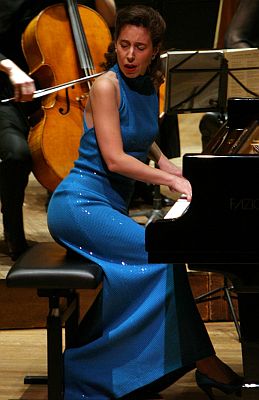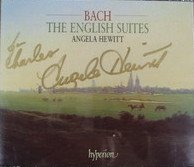 Angela Hewitt is not only a favorite at Ionarts Central: her Bach (and beyond) is always respected , often beloved, by the many listeners and critics who have come to hear these, for the most part, very successful albums on Hyperion covering the entire Bach output for solo keyboard (see our recent review of her English Suites). With the concertos under her belt as well, she now turns her eye to other composers – Chopin, Couperin (v.1, v.2) and Chabrier as of late. A contemporary of François Couperin (1668 – 1733), Jean-Philippe Rameau (1683 – 1764) is next – and it was his suite in a-minor that opened her recital at Shriver Hall in Baltimore last Sunday.
Angela Hewitt is not only a favorite at Ionarts Central: her Bach (and beyond) is always respected , often beloved, by the many listeners and critics who have come to hear these, for the most part, very successful albums on Hyperion covering the entire Bach output for solo keyboard (see our recent review of her English Suites). With the concertos under her belt as well, she now turns her eye to other composers – Chopin, Couperin (v.1, v.2) and Chabrier as of late. A contemporary of François Couperin (1668 – 1733), Jean-Philippe Rameau (1683 – 1764) is next – and it was his suite in a-minor that opened her recital at Shriver Hall in Baltimore last Sunday.
Bach on the piano is a debate no longer worth any serious music lover’s time. Ditto for Domenico Scarlatti who – save for a few effects – works equally well on either piano or harpsichord also. When it comes to French Baroque music for the keyboard, the opinions are – for now, at any rate – fairly unanimous: most of it is not helped by the modern piano; much of it diminished. I don’t suppose that Angela Hewitt would necessarily disagree with that. There is a reason why she – now on her third volume of Couperin keyboard music – very judiciously chooses what to tackle with the piano and what to leave the harpsichord’s prerogative rather than aiming for a “complete works” recording, insensitive to the musical material’s demands.
The a-minor suite was a microcosm of that conundrum. Although every part was finely played, delicately nuanced, tactfully enunciated, there were parts that audibly adapted better to the Shriver Hall’s Steinway than others. The opening Allemande (stalking somewhat through its own beauty) and following Courante (its trills and ornaments isolated on an empty plain; with several moments far from smooth) were among the latter. The Sarabande in its rolling, stately nobility and the rollicking La Triomphante as well as the discursive, long Gavotte et Doubles (what a supreme finale!) among the former. Since those parts came after Allemande and Courante and were not stopped in their cumulative power by Les Trois Mains and Fanfarinette, the impact was tremendous; seeing Ms. Hewitt work the keys in this repertoire delicious in its own right.

J. S. Bach, French Suites, Angela Hewitt

J. S. Bach, Toccatas, Angela Hewitt

J. S. Bach, The Six Partitas, Angela Hewitt

J. S. Bach, Inventions, Chromatic F'n'F, Fantasia in c-minor, Angela Hewitt |
Her Bach -- joyous, unindulgent, light (but never “precious”), floating -- needs little introduction. At her best she is to be preferred over the excellent Murray Perahia (who has done far too little Bach!) and reliable András Schiff. At her least successful she is just a touch behind Schiff and still ahead of the rest. Glenn Gould, who ranges from the madly inspired (
Goldberg Variations) to plain awful (Toccatas) runs outside the competition, anyway… but there would be little of Gould I’d ever recommend over Hewitt.
Partita No. 4 in D-major (BWV 828) was the particular example in this recital, and her subtleties, her touch, the shifts in dynamics (small but immediately impressing character) just about sublime. She was not far from inducing tears of touched joy with just half a dozen notes played in just the way she does. I suppose that is what it means when a pianist is said to be able to “tell a story with two notes.” Yet – and I am grateful for that – hers was not an emotional performance, which is a style that simply would not be Hewitt’s. It is that mixture of delicacy with spine and determination that makes her Bach so often so appealing; her grace and rigor. Kitten here, princess there, tomboy around the corner. The result is beauty that makes no claims to Baroque “authenticity” nor ever evokes the impression of “interpretation”.
Brahms’s sonatas can’t be said to elicit particular anticipation on my part – nor would I necessarily associate Angela Hewitt with that repertoire. That said, she’s certainly not a specialist pianist, despite all that Bach, and of those sonatas, the F minor work still holds the most appeal for me. And sure enough, Ms. Hewitt proved her chops in the storm-brewing
Allegro maestoso that swerves so gently back to tenderness and then grandeur again. Here, Hewitt’s knack for seamless transitions and calm amid tempestuous moments brought about immediate and most rewarding returns; returns that note-perfection could hardly have yielded. Of course there are few works where technical perfection outweighs sheer musicality (Alkan,
Godowsky,
sometimes Liszt) and far more where, without a particularly deft touch, the music cannot take off. Hence it takes a
Radu Lupu or
Julius Katchen to turn much of the Brahms piano compositions into obviously great music – and similarly it was Hewitt’s ability to shade and contrast that made Brahms a joy and the listener overlook the good amount of slips.
Indeed, with her un-self-conscious tonal delicacy and variety, my ears were willing to forgive far more and far more readily than when
Fleisher tackled the great Schubert B-flat at Shriver last month. Although the sonata's peak outbreaks were clipped at the top (like an amplifier would, when output signal attempts to exceed the supply voltage), the in-between, the valleys of piano and pianissimo and the ascent to
ff and descent back to
pp had me in rapture. Her Brahms thus became a living memorial to music being quite its own category of expression and quality; far away from being an Olympian sport where “faster, higher, further” would be all that mattered – even if that is often how musical virtuosos are marketed these days. All Beckmessers begone: this was simply superb!
So thought the audience, too: Ms. Hewitt was cajoled into giving an encore: the
Andante from the
Sonata in d-minor, BWV 964; a ‘beaut’ and a fitting nightcap on one of the two best piano recitals this season. (Although this evening will hopefully add another – when
Maurizio Pollini comes to Strathmore.)
 Additional Comments by Charles T. Downey: Additional Comments by Charles T. Downey:
With her tall, thin frame sheathed in a soft blue gown revealing her shoulders, Canadian pianist Angela Hewitt played in her rather gestural style (lots of balletic whirling of arms), and her face often accompanied final or significant musical gestures with expressions of surprise, empathy, and even ecstasy (see photo at left). Far from being distracting, I found her mannerisms to be nothing more than the expression of her sincere feeling for the music she was playing.
Hewitt opened with a programming choice that immediately won me over, as a musicologist obsessed with the French Baroque era. Jean-Philippe Rameau published this A minor suite in his third book of keyboard pieces, intended for the harpsichord, in 1728. This was one of the two suites included on Alexandre Tharaud's 2002 recording of Rameau's keyboard music (paired there with Debussy's Hommage à Rameau), which we will be reviewing soon at Ionarts. Indeed, Angela Hewitt will be recording this suite and two others by Rameau in June for a new recording to be released next year. That fluttering sound you hear is a musicologist's heart floating to heaven. Major concert artists are playing Rameau's music.
Hewitt's allemande was gentle, whirring with the cloud of agréments in Rameau's score. The composer included so many probably as a way to extend the harpischord's fragile sound, and it is often difficult to render delicately on the stronger piano. Hewitt struck the perfect solution, including all or at least the lion's share of the ornaments but without them drawing attention to themselves for the most part. The arching sequences and harmonic virtuosity of the allemande bring to mind Rameau's other role as daunting music theorist. One of the more challenging parts of the suite is the playful fourth movement ("Les Trois Mains"), in which the left hand crosses frequently above the right to make a guest appearance as a phantom "third hand." This was exceedingly well played, as was the folksy fifth movement ("Fanfarinette"), thick with ornamentation. Only the sixth movement ("La Triomphante") sounded rocky, perhaps at a tempo slightly too fast to accommodate the ornamentation and imitative demands. Hewitt wisely played it without repeats.
There is one overpowering reason to play this suite, and that is for the final movement, a dreamy gavotte, and its six doubles, embellished versions or full variations. Hewitt excels in this kind of music, ranging from delicate to full (but rarely over the top), with knotted inner lines that require the untangling power of her capable hands. In one double, the thumb and lower fingers of her right hand skated super-legato through roulades of sixteenth notes, while the upper fingers of the same hand flawlessly sounded the melody. In another double her right hand floated above her left, sounding repeated notes in a graceful choreography. She had most of the power needed for the final double, Rameau's attempt to get an orchestral sound from the keyboard. After this beautiful performance, I can say with confidence that I am looking forward to her Rameau disc. |

































































